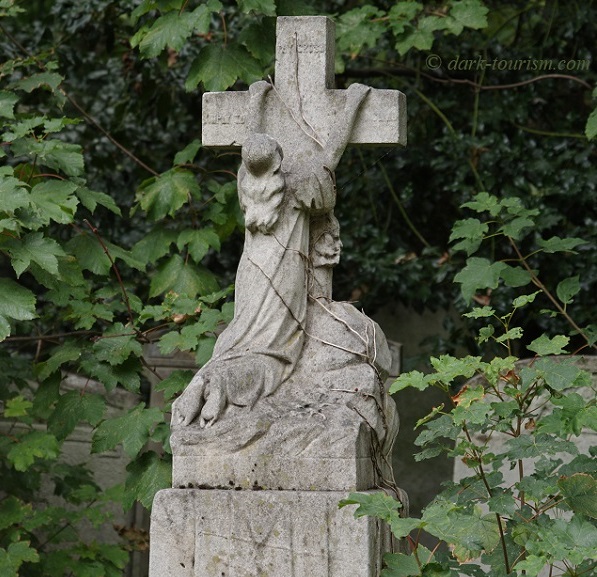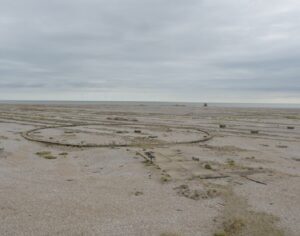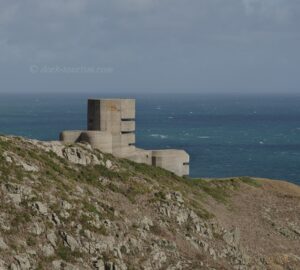This is a follow-up post to the previous one, in which I reported on my DT-filled, four-week-long road trip through England. This ended in late August in London, where I dropped off my hire car at Heathrow Airport. After that I did not catch a flight, but took the Tube into, or rather: through London. I had a cheap hotel room for three nights booked far out east at the Royal Docks (named after Victoria, Albert and King George V). I picked that place not only for its (by London standards) very affordable rates and the fact that it was easily reachable by the “Elizabeth Line” (the newest of the London Tube lines, and what a splendidly convenient addition to the network it is). It also had an element of going down memory lane …
The London Docklands were one of my earliest travel fascinations. This takes me back to the early 1980s (yes, I’m that old!), and I even remember seeing the Royal Docks still in use, just before they were closed for good in 1981, after all the other docks within London had long been abandoned. I developed quite an obsession with “industrial archaeology”, as the lingo goes. I fondly remember exploring what remained of the Surrey Docks and its empty warehouses (today we’d say I went “urbexing”) before the whole complex disappeared, all lost to “redevelopment”. Today very little of the London Docklands still has original bits and pieces in place. The largest of these is the imposing Spillers Millennium Mills building on Victoria Dock. This is what it looked like in late August this year:
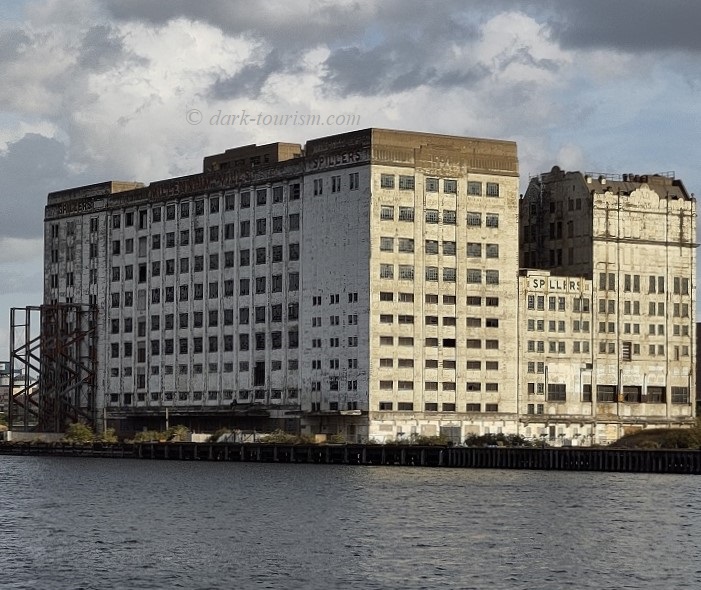
I once had an unsuccessful attempt at getting into this building in the 80s that was thwarted by security. This time I didn’t even bother trying, since I had read that the interior has meanwhile been completely gutted and the whole structure is now also awaiting “redevelopment”. Until a few years ago, though, the Millennium Mills building was a prime destination for urbexers more determined, daring and lucky than me – and they’ve put some fabulous urbex photo series out on the Internet (see e.g. this one – external link, opens in a new tab).
This stay in London was my second this year (and at least the 20th or so in my life – I’ve long lost count), after I had tagged on a few days in the British capital after New Year, and amongst other things revisited Highgate Cemetery, which yielded this Blog post.
Highgate is the most celebrated of the so-called “Magnificent Seven” of Victorian-era cemeteries in London. I had long wanted to visit the other six as well (including Kensal Green Cemetery, which I did once visit but that was in the 80s and I don’t have any photos). Given the location of my hotel out east, the easiest one to slot in on this occasion was Tower Hamlets Cemetery. When I planned my route online I happened upon something along the way whose name attracted my attention: the “Ragged School Museum”. Intrigued I looked up their website and decided to pay the place a visit. Here’s a photo of the building right by Regent’s Canal:
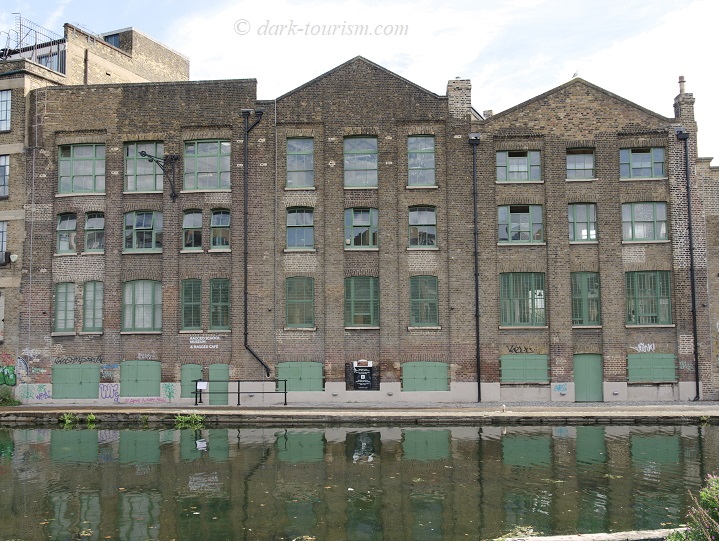
A “Ragged School” was a charity scheme founded by one Dr. Thomas Barnardo from Dublin, who came to London in the second half of the 19th century and was confronted with widespread poverty, disease and destitution amongst the working-class people in the East End of the city. The free “Ragged Schools” were to alleviate the plight of poor children and adolescents and provide them with a basic education and some work. This school in Mile End started operating in 1877 and closed in 1908, at a time when state-funded schools were becoming more common. The purpose of the “Ragged School” is nicely depicted in this exhibit at today’s museum, a sort of before-and-after juxtaposition:
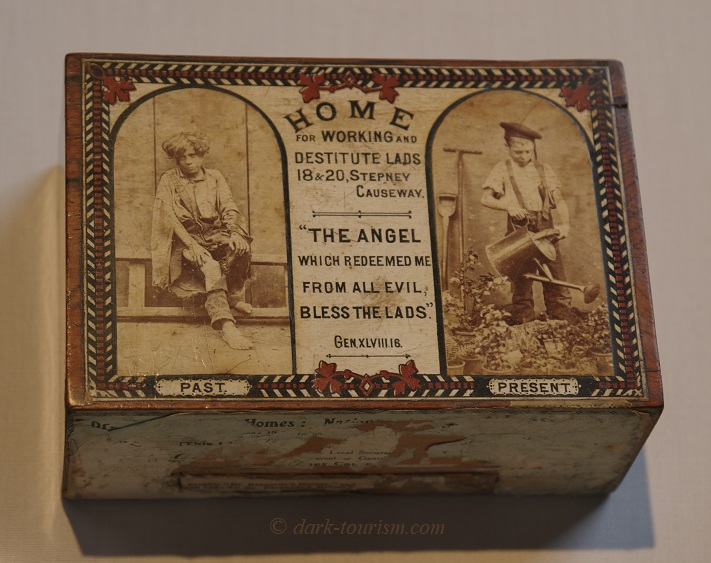
The museum was first opened in 1990 and in 2020 underwent substantial refurbishment. It includes this reconstructed period classroom:
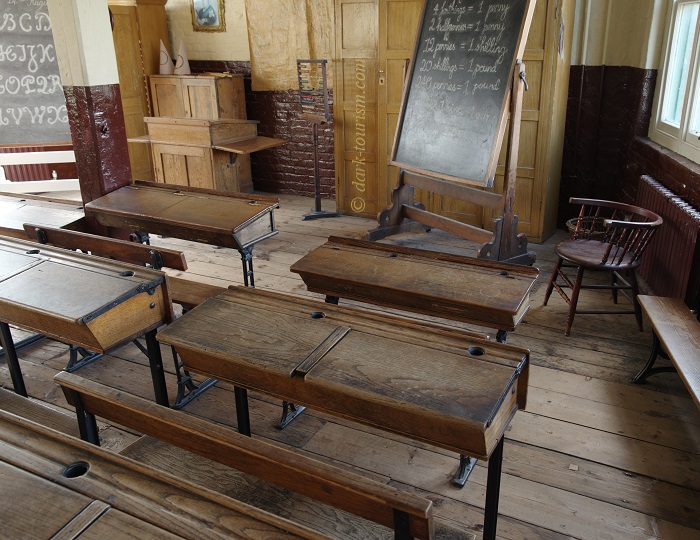
When I visited the nearby Tower Hamlets Cemetery, I found a connection to the “Ragged School”, namely a symbolic tombstone for some of Dr. Barnardo’s children:
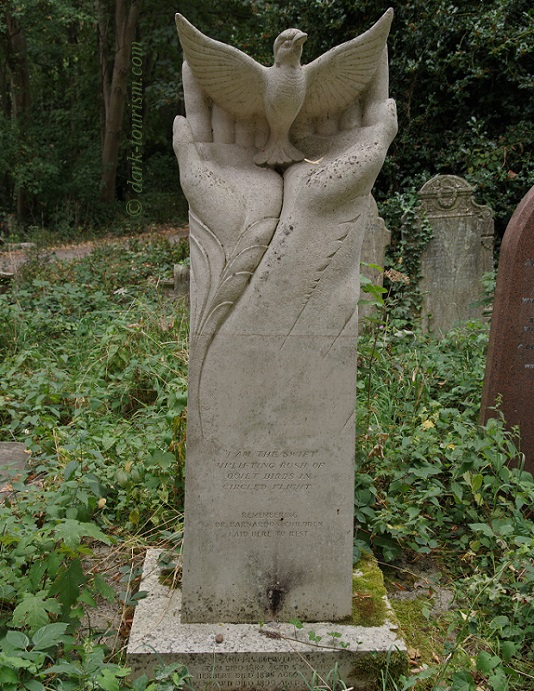
The cemetery is (unlike Highgate) not in use any more (the last burial took place in 1966) and like the other “Magnificant Seven” became atmospherically overgrown after decades of disuse:
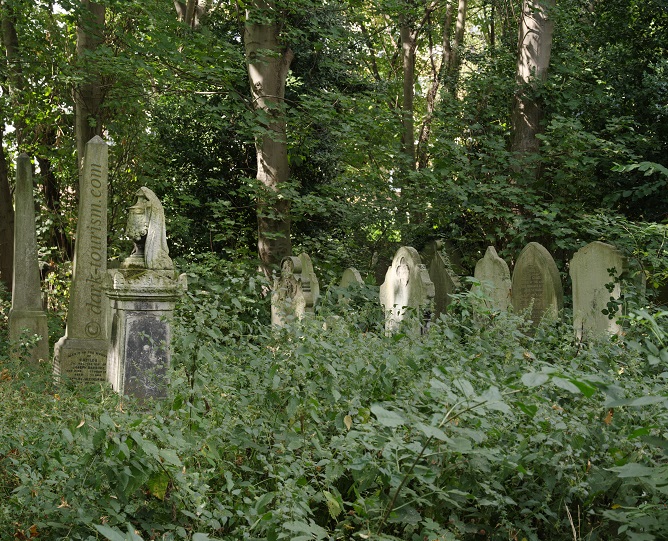
There’s a Friends of Tower Hamlets Cemetery association, who have turned the site into a sort of public park and cleared the pathways and cut away some of the invasive vegetation, similar, again, to Highgate. Overall, Tower Hamlets Cemetery, while a nicely dark attraction, can in my view not quite compete with its more famous counterpart in Highgate, but it too features some typically Victorian sepulchral works of art. Here’s one of my favourite examples I spotted there (same photo as the featured one at the top of this post):
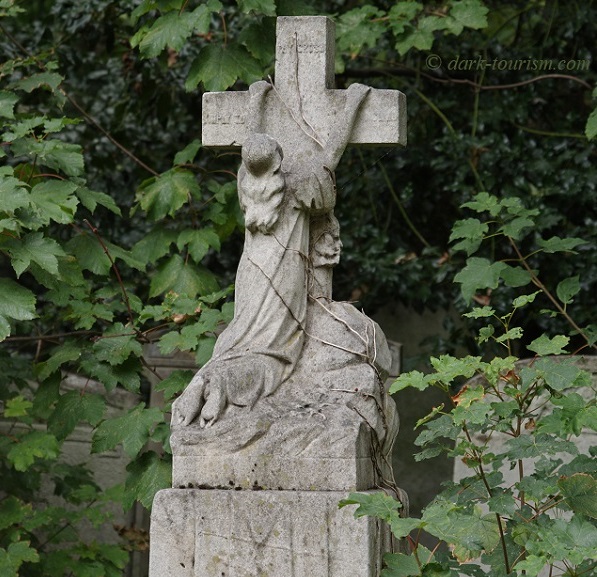
Perhaps the most legendary case of a serial killer who’s never been identified is that of “Jack the Ripper”. This was the nickname given to the perpetrator of a number of brutal murders of prostitutes in the impoverished East End of London in 1888, which caused an early media sensation of unprecedented proportions. Owing to the similarities of the butchering, which suggested the murderer may have had special skills (maybe he was actually a butcher, or possibly a surgeon even?), they were attributed to the same person. Many theories have been put forward, books written, feature films made, which settle for specific identities, but ultimately the real identity of Jack the Ripper will in all likelihood never be determined for sure. And in terms of dark tourism, the Jack-the-Ripper legend has spawned its offerings too.
I’ve long known about those Jack-the-Ripper walking tours, but have never been tempted – not so much because I’d find them too ghoulish but rather because there’s nothing much to see. The locations involved have all changed beyond recognition since 1888, and I’ve never deemed it worth my time and money to follow a guide around telling well familiar stories and showing photos you could just as well look up online. In 2015, however, a proper Jack the Ripper Museum was opened. It’s seen as controversial by some critics, who accuse the museum of celebrating a serial killer. I’ve seen things like that before (e.g. at the Museum of Death in L.A.) and had hence been reluctant to visit this London museum up to now. But on this occasion I overcame my hesitation and incorporated the Jack the Ripper Museum into my itinerary. While some elements of the museum could be seen as a bit cheesy, I would not agree that the museum “glorifies” the murderer or his deeds. In fact, it provides lots of background information about the impoverished living conditions in the East End back then and, in particular, about the plight of women, in addition to taking a closer look at the police investigations and the media hype. It really isn’t so bad.
There are many life-size, walk-in “dioramas” or reconstructions in this museum too, including this one depicting the discovery of one of the victims (possibly Elizabeth Stride, as the dummy body is not mutilated):
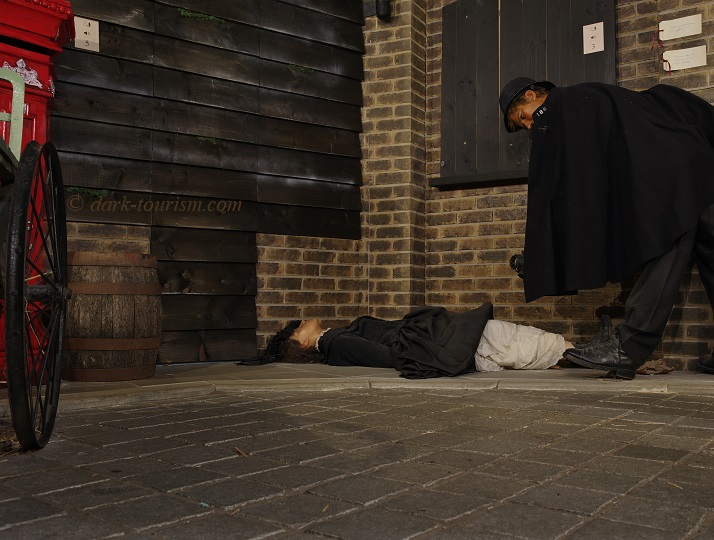
Amongst the artefacts on display is this original sign that used to hang on the wall inside the “Ten Bells” pub in Spitalfields:
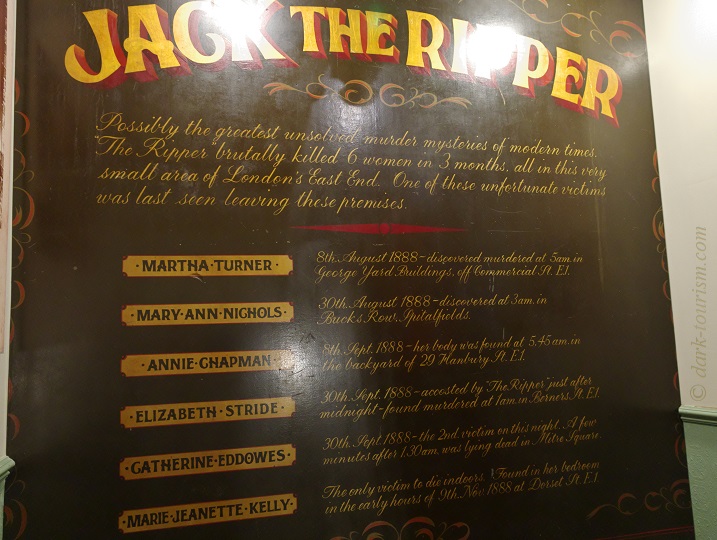
Contrary to the commonly named “Canonical Five”, this sign also includes a sixth name, Martha Turner, one that is not normally associated with the Ripper case. Why it’s included seems to be a bit of a mystery; it may also be a misspelling of Martha Tabram, who was indeed murdered in the area on 7 August 1888, whether by the Ripper or not is contested.
Another, much longer established institution I visited was the Hunterian Museum. This belongs to the category of medical exhibitions and is based to a large extent on the collection of specimens amassed by John Hunter, after whom the museum is named and which is located in the Royal College of Surgeons of England. Here’s a photo of the front facade:
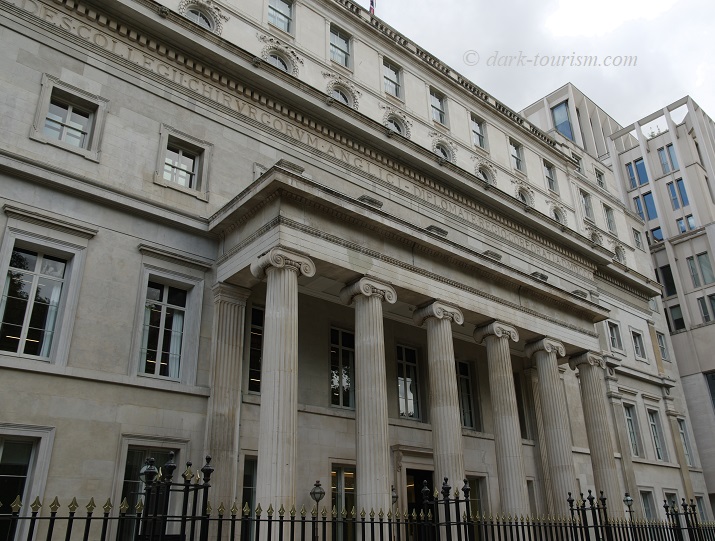
The exhibition includes countless more or less grisly displays, ranging from animal skulls to really icky items such a skull showing devastating symptoms of syphilis (there’s also a row of pickled penises affected by the same disease). Permission to take photos came with the proviso that none can be posted online, so I can’t give you any illustrative evidence here. You just have to take my word for it that this is indeed a very worthwhile museum to visit for anybody with at least a passing interest in all things medical. The modern section impressed me most, where the latest developments in the medical art and new inventions are the focus. For instance there is a “PillCam”, a miniature camera the size of a pill, which you swallow and the cam is then operated by remote control as it passes through the body to take images otherwise only obtainable by endoscopic means. The most fascinating part of the museum, however, was a series of videos with “testimonials” covering a range of specific cases, both from the patients’ and the medical professionals’ perspective (in one case that was the same person!). The most stunning element was footage of a woman playing the violin whilst undergoing brain surgery!
Apart from museums and the cemetery I also sought out a number of monuments, and along the way discovered even more. The one I was most keen to see was a rather new and unusual one – the National Covid Memorial Wall:
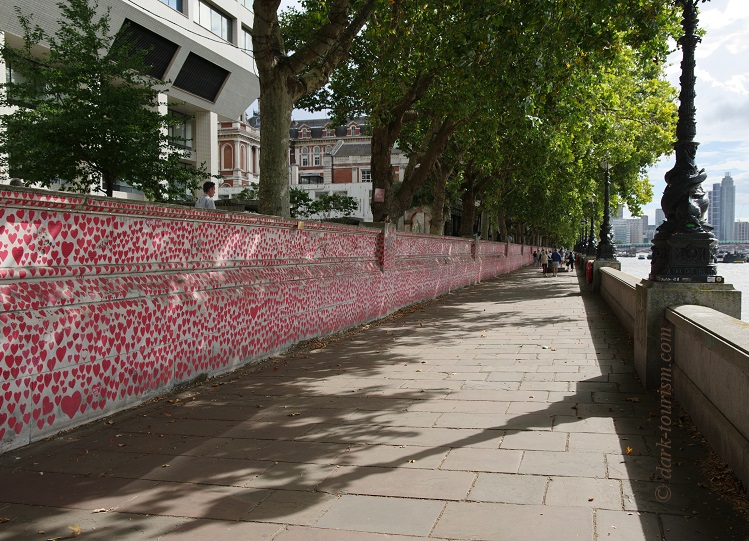
It was started in March 2021 as a grass-roots initiative by bereaved relatives of victims of the pandemic. In the meantime it has been officially sanctioned and an association of volunteers called “Friends of the Wall” now look after and maintain the memorial. On the wall are over 240,000 red hearts, mostly with short dedications written on them, and each stands for one of those people in the UK whose death certificate states Covid-19 as the direct cause of death. The wall stretches for ca. 500m along the southern embankment of the River Thames, next to St Thomas’ Hospital.
At one point I spotted a little plaque not related to Covid but to the victims of an earlier spooky disease:
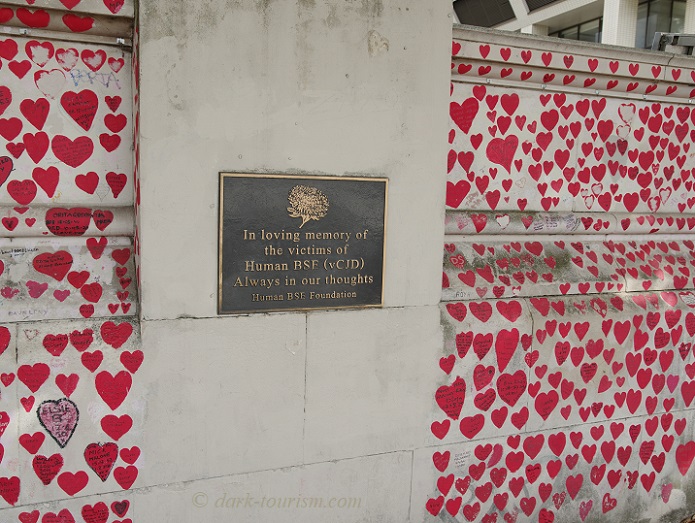
BSE, ‘bovine spongiform encephalopathy’, is also known as “mad cow disease”, and vCJD, ‘variant Creutzfeldt-Jakob Disease’, is the human form of this fatal degenerative brain condition. I remember the BSE crisis well – it was what prompted me to give up eating meat back in 1990, at a time when it was not clear whether BSE-triggered vCJD could take on epidemic proportions (in the end it didn’t, because apparently only a certain, and rare, structural precondition lets the human form develop; hence case numbers remained comparatively low).
The location of the wall is also politically charged, as it is right opposite the Houses of Parliament (aka Palace of Westminster), the seat of British government – and the handling of the Covid pandemic under PM Boris Johnson’s government at the time attracted severe criticism (and before that the handling of BSE crisis was also not without its critics). So the wall being so visible from the windows of Westminster is a statement. In that sense one can argue that the building itself also has its dark aspects – so I include a photo of it here too:
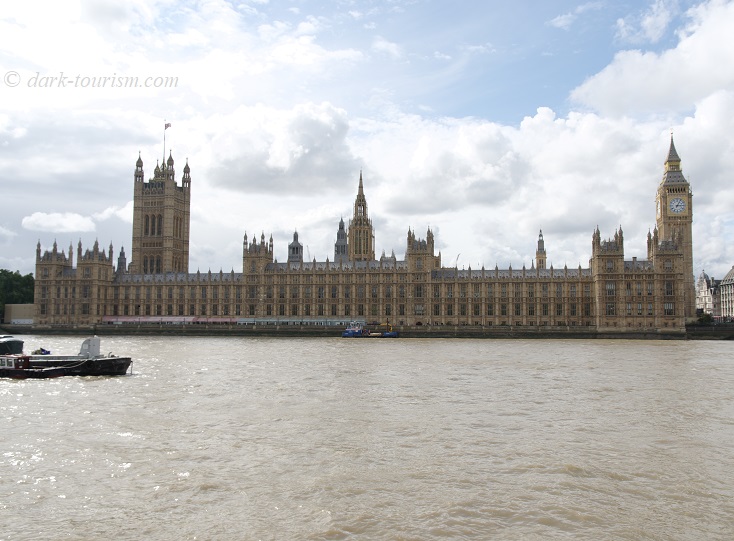
On Westminster Bridge I also spotted a small plaque dedicated to the victims of the terrorist attack on that bridge on 22 March 2017.
Another terrorism memorial monument that I was keen to finally see with my own eyes is the “7/7 Memorial” in Hyde Park:
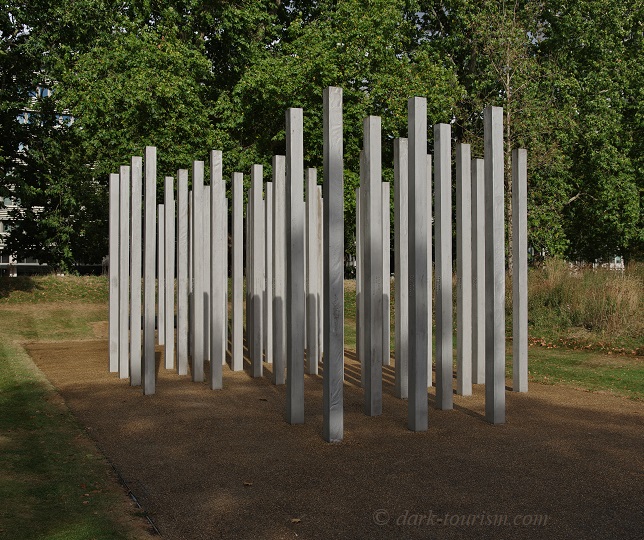
This commemorates the co-ordinated al-Qaeda suicide bombing attacks of 7 July 2005 that took place at four different locations across London, on three trains and one double-decker bus of the London transport system. The 52 steel stelae stand for those victims killed in the attack, grouped together to represent the four locations, the names of which are embossed on the stelae. A separate plaque set into the ground lists the victims’ names.
Also in Hyde Park is a much older memorial monument that I had hitherto never seen. But ever since I had read about it in this book I wanted to pop by and take a look. It marks the Holocaust Memorial Garden:
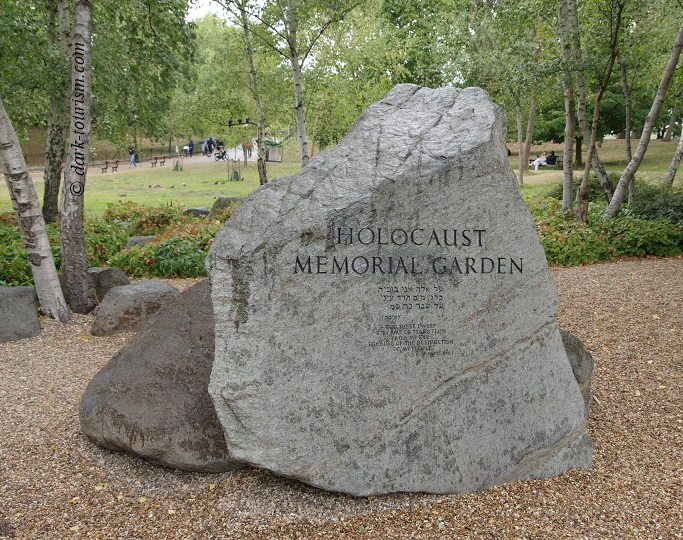
This modest stone monument was unveiled already in 1983, but I had never heard of it or stumbled upon it. And it is indeed simple and not especially dramatic – but that was the style of the time (in the chapter “The Omnishambles” the author of this book very sensibly put this monument into its commemorative and political context, while severely criticizing later developments on the Holocaust remembrance front – well worth reading!).
Not quite in Hyde Park but right on the edge of it, namely on an elongated traffic island in Park Lane stands another noteworthy monument that more recent, erected in 2004. This is the Animals in War Memorial:
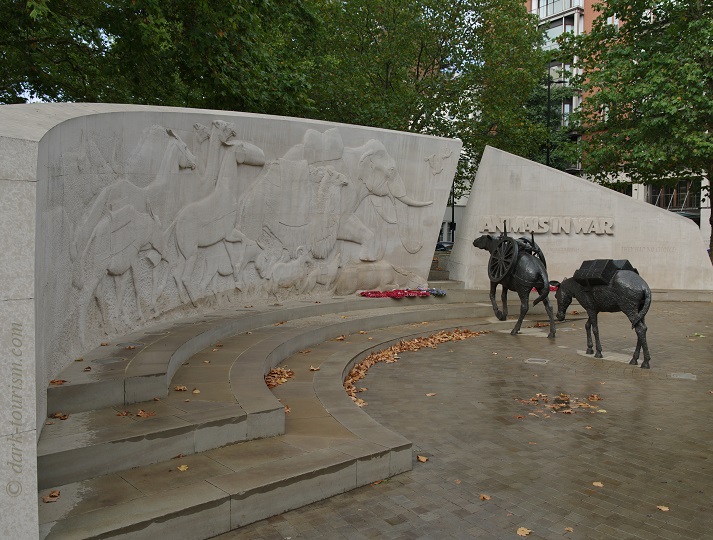
Animals have of course been used in warfare since times immemorial, and right into the 20th century. Millions of horses, mules and donkeys died in WW1. Elephants, oxen and camels, also depicted on the memorial’s main wall, were (and possibly still are) used by the military in other parts of the world too. Countless homing pigeons delivered messages in both world wars, and dogs were used for a variety of purposes. What I cannot so easily figure out is why there’s also a goat amongst the species depicted. I could only think of a goat’s role as a kind of mascot – but then some other species are omitted, e.g. monkeys, pigs or parrots. Never mind, the monument is certainly striking, perhaps a bit OTT even, with the two suitably dejected looking bronze mules with their burdens of military equipment trotting towards the opening in the memorial’s main wall. By the way, you can never see the whole monument all at once, because behind that curved wall it continues with two more bronze sculptures, a horse and a dog, atop a grassy mound of earth – to see those you have to be on the other side or across the road, from where you can no longer see the bas-relief wall’s depictions or the two mule sculptures.
Another monument that I searched out was one I had happened upon by chance when looking for the Battle of Britain Bunker on Google Maps. I found out that since 2005 there has also been a Battle of Britain Monument on Victoria Embankment. It even has its own dedicated website (external link, opens in a new tab) explaining the monument in detail. Here’s a view of the main section with the “scrambling” pilots in the centre:
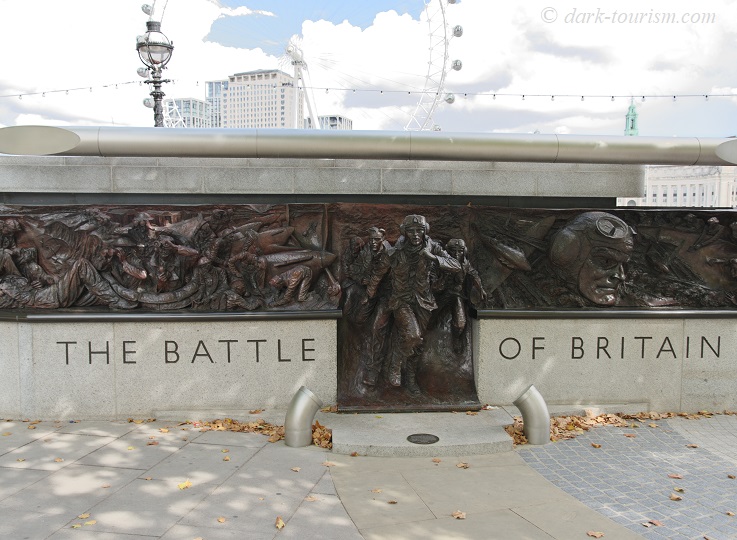
Here I can’t go into the details of all the symbolism in the bronze bas-relief that is wrapped around the whole monument (consult the website for the artist’s explanations) – but take a look at that oversized pilot’s head on the right. I find that almost reminiscent of the socialist-realist big head at the Brest Fortress Monument …
In addition, I came across a number of monuments in London that I had never been aware of at all, so they were complete chance finds. One is the huge memorial complex dedicated to those who lost their lives as civilian sailors – it’s the Merchant Navy Monument opposite the Tower of London in Trinity Square:
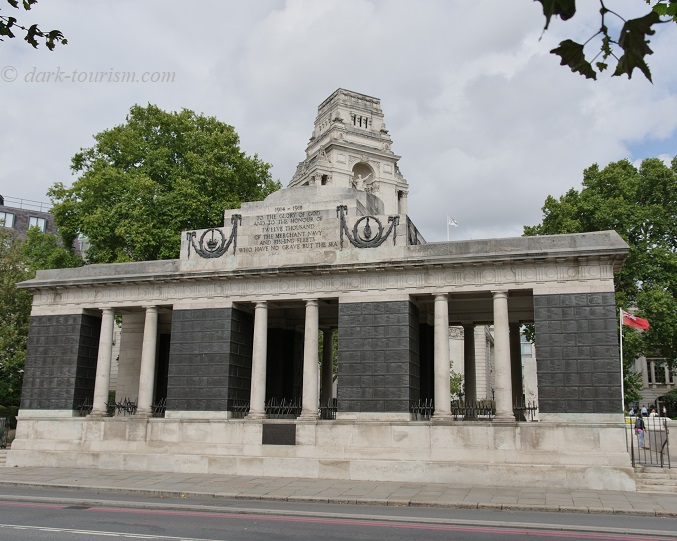
Another chance find was this Korean War Monument:
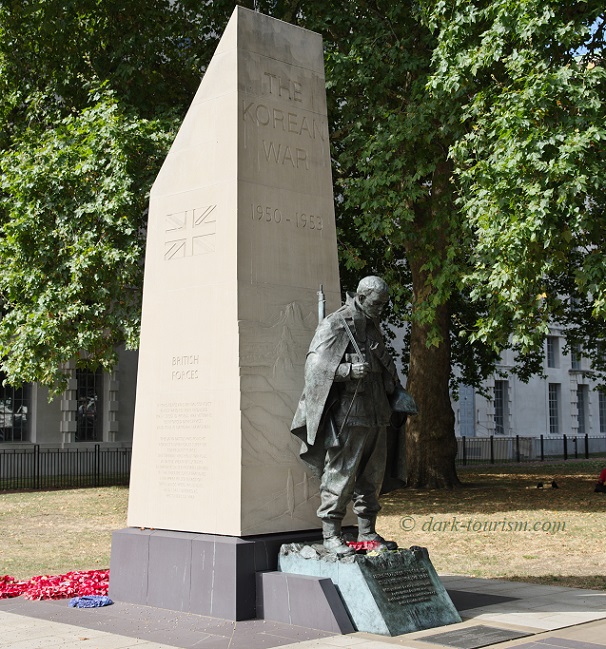
It’s a fairly modest and classic affair, fitting for a war that took place in the 1950s. Much newer, more modern and more abstract is this nearby monument commemorating Britain’s military involvement in Iraq and Afghanistan:
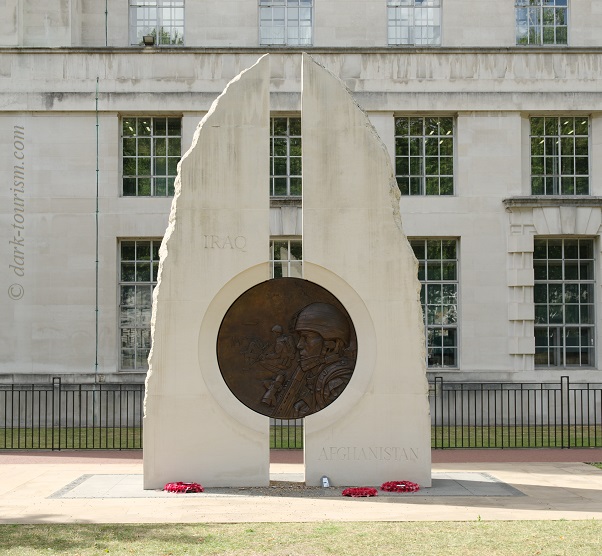
Both of these monuments within Victoria Embankment Gardens are part of a whole collection of military-history memorials, but I’ll leave it at these as examples.
And with this I’ll draw this Blog post to a close.
.
.
.
.
.

